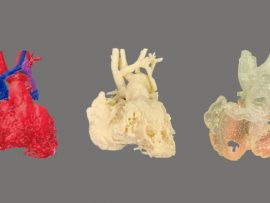Abstract The purpose of this study was to evaluate left ventricular (LV) unloading strategies in patients supported with peripheral venoarterial extracorporeal membrane oxygenation (VA-ECMO). A retrospective review was conducted of..
Lee masAbstract Background Extracorporeal membrane oxygenation (ECMO) is increasingly used to support patients with severe acute respiratory distress syndrome (ARDS). The impact of ECMO on long-term outcomes of patients with severe..
Lee masAbstract Objectives: Extracorporeal cardiopulmonary resuscitation (ECPR) is the implementation of venoarterial extracorporeal membrane oxygenation (VA-ECMO) during refractory cardiac arrest. The role of left-ventricular (LV) unloading with Impella in addition to..
Lee masAbstract Haemorrhagic shock is frequent in critical care settings and responsible for a high mortality rate due to multiple organ dysfunction and coagulopathy. The management of critically ill patients with..
Lee masAbstract Objective We conducted a prospective study to assess the face and content validity of a new virtual reality (VR) extracorporeal circulation simulator (ECC) developed for perfusionists to facilitate training..
Lee masAbstract Introduction Critically ill patients supported with venoarterial (VA ECMO) are at risk of developing severe arterial , which has been associated with increased mortality. Lower saturation targets in this population may..
Lee masAbstract Patients undergoing coronary revascularization with extracorporeal circulation or cardiopulmonary bypass (CPB) may develop several biochemical changes in the microcirculation that lead to a systemic inflammatory response. Surgical incision, post-CPB..
Lee masAbstract Objective. To evaluate the effect of NO added to the sweep gas of the oxygenator during cardiopulmonary bypass (CPB) on the liver and kidneys in pigs. Methods. An experiment..
Lee masAbstract Purpose Cold-stored platelets (CSP) are an increasingly active topic of international research. They are maintained at 1–6 °C, in contrast to standard room-temperature platelets (RTP) kept at 20–24 °C. Recent evidence..
Lee masAbstract This study presents Neuro-SPARK, the first scoring system developed to assess the risk of neurologic injury in pediatric and neonatal patients on extracorporeal membrane oxygenation (ECMO). Using the extracorporeal..
Lee masSimultaneous upper and lower body perfusion using hypothermia during thoracoabdominal aortic surgery
Abstract Background In open thoracoabdominal aortic aneurysm (TAAA) repair, we have been performing vascular reconstruction under moderate to deep hypothermia and assisted circulation using simultaneous upper and lower body perfusion...
Lee masAbstract Hemolysis is a complication of cardiopulmonary bypass (CPB). Carboxyhemoglobin (COHb) and methemoglobin (MetHb) were suggested as potential hemolysis biomarkers. This retrospective study was based on a prospective registry aimed..
Lee masAbstract Objective We designed a simplified total arch reconstruction (s-TAR) technique which could be performed under mild hypothermia (30–32 °C) with distal aortic perfusion. This study aimed to compare its efficacy..
Lee masAbstract Introduction The WHO Surgical Safety Checklist (SSC) is a communication tool that improves teamwork and patient outcomes. SSC effectiveness is dependent on implementation fidelity. Administrative audits fail to capture most..
Lee masAbstract Background The use of cardiopulmonary bypass (CPB) is almost inevitable in cardiac surgery. However, it can cause complications, including hemolysis. Until now, there have not been any standards for..
Lee masAbstract Objectives Extracorporeal life support (ECLS) pertains to therapeutic and prophylactic techniques utilized in a wide range of medical applications, with severe pulmonary diseases being the most prominent cases. Over..
Lee masAbstract Antithrombin (AT) is a natural anticoagulant pivotal in inactivating serine protease enzymes in the coagulation cascade, making it a potent inhibitor of blood clot formation. AT also possesses anti-inflammatory..
Lee masAbstract Objective: Controversy remains regarding the optimal neuroprotection strategy for elective hemiarch replacement (HEMI). This study sought to compare outcomes in patients who underwent HEMI utilizing the 2 most common..
Lee masAbstract OBJECTIVES: To describe factors associated with failed extubation (FE) in neonates following cardiovascular surgery, and the relationship with clinical outcomes. DESIGN: Retrospective cohort study. SETTING: Twenty-bed pediatric cardiac ICU..
Lee masAbstract Background Children with end-stage lung disease are commonly managed with extracorporeal life support (ECLS) as a bridge to lung transplantation. A pumpless artificial lung (MLung) is a portable alternative..
Lee masAbstract Cardiac Surgery-Associated Acute Kidney Injury (CSA-AKI) is a serious complication seen in approximately 20–30% of cardiac surgery patients. The underlying pathophysiology is complex, often involving both patient- and procedure..
Lee masAbstract Background The Safety Case is a regulatory technique that requires organisations to demonstrate to regulators that they have systematically identified hazards in their systems and reduced risks to being as..
Lee masAbstract Objectives Anemia and transfusion are common in cardiac surgery patients, and are associated with significant morbidity and mortality. Multiple perioperative interventions have been described to reduce blood transfusion, but..
Lee masAbstract Medical 3-dimensional (3D) printing refers to the creation of physical anatomical structures derived from volumetric datasets from various imaging modalities. Applications of this technology include advanced visualization and diagnosis,..
Lee masAbstract Objective To compare mortality trends in patients requiring Extracorporeal Membrane Oxygenation (ECMO) support between the first quarters of 2019 and 2020 and determine whether these trends might have predicted..
Lee masAbstract Ensuring organisations learn from patient safety incidents is a key aim for healthcare organisations. The role that human factors and systems thinking can have to enable organisations learn from..
Lee masAbstract Background: This document updates previously published Clinical Practice Guidelines for the management of patients with acute respiratory distress syndrome (ARDS), incorporating new evidence addressing the use of corticosteroids, venovenous extracorporeal..
Lee masAbstract Severe acute hypercapnia is independently associated with increased adverse effects and intensive care unit mortality in mechanically ventilated patients. During the severe acute respiratory syndrome coronavirus 2 (COVID-19) pandemic,..
Lee masAbstract Extracorporeal membrane oxygenation (ECMO) has had increasing prevalence and indications in the last decade. Calcium channel blocker overdose (CCBOD) can lead to significant cardiopulmonary dysfunction and has also increased..
Lee masAbstract The 2 hypnotic agents currently used for the maintenance of general anesthesia during cardiopulmonary bypass (CPB) are propofol and sevoflurane. Propofol can be administered directly into the cardiotome of..
Lee mas













